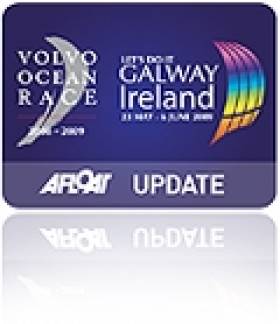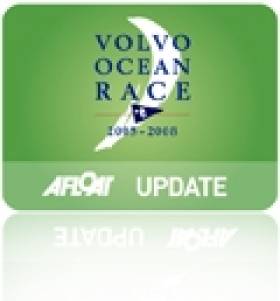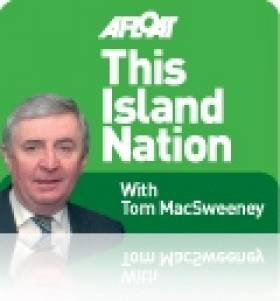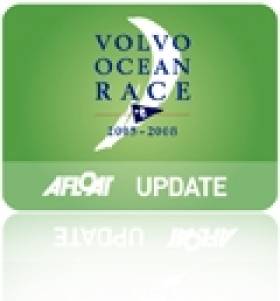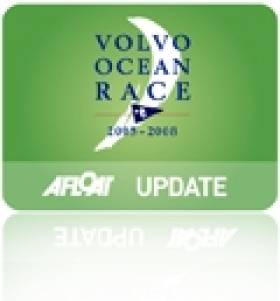Displaying items by tag: Galway
Free Mobile App for Visitors to Volvo Ocean Race Galway
#VOLVO OCEAN RACE - Silicon Republic reports that researchers at NUI Galway have created a free mobile app for visitors to the city during the Volvo Ocean Race festivities starting this weekend.
Graduate students at the university's Digital Enterprise Research Institute (DERI) developed the app to provide visitors with up-to-date details of the festival programme from 30 June to 8 July - such as the slipway locations and dock gate opening times - as well as handy hints and tips for making the most of the City of the Tribes.
The DERI team have also integrated some of their own social technologies into the app such as 'Connect and Chat' and 'Tweet Cliques' so users can connect with their friends in the city.
The Volvo Ocean Race Festival Galway app is available from Apple's App Store and from the Google Play store for Android devices.
Silicon Republic has more on the story HERE.
#VOLVO OCEAN RACE - A Fine Gael senator last week called on the people of Galway to raise €100,000 for arts and culture events during the Volvo Ocean Race finale, The Irish Times reports.
Senator Fidelma Healy-Eames said the funding raised by event organisers Let's Do It Galway would be matched with €20,000 from the State by Arts Minister Jimmy Deenihan under a "philanthropy leverage initiative".
Private sponsorship has so far been slow off the mark for the week-long festivities surrounding the race conclusion, with the cost of events – including the biggest free open-air music festival of the year - expected to reach a total of €7 million.
#VOR – Craft on the water in the Galway bay area may be inspected by the Garda Water Unit according to a marine notice issued tonight by Galway Harbour Company setting out how pleasure craft are to behave during the Volvo Ocean Race finale from June 30th.
Galway Harbour Master Brian Sheridan who issued the notice says the 'safety of all while afloat during the Volvo Ocean Race Stopover at Galway is of prime importance'.
The notice also prohibits the use of tenders or dinghies to get ashore from a swinging mooring instead a Water Taxi service should be used.
In accordance with the Maritime Safety Act 2005, the Garda Water Unit will be paying particular attention to lifejacket use, vessel seaworthiness, vessel insurance and alcohol abuse.
The Irish Coast Guard will continue to monitor the following VHF Channels on Galway Bay: Ch 16, 67, 04 & Digital Selective Calling DSC70.
The full notice is available for download below as a pdf document.
The Pace Picks Up in Galway
#islandnation – THIS WEEK : Smelly humans, the pace picks up in Galway, pirates in Baltimore, the response of fishermen to the condescending RNLI and a Cork beauty are amongst my topics this week, read on .....
GALWAY PACE PICKS UP
There is an increasing buzz of excitement in Galway where the pace has picked up notably this week with work well underway on constructing the Volvo Ocean Race Village and increasing hope that Damian Foxall could be representing Ireland on the overall Volvo winners' podium in the City of the Tribes. It is still disappointing that the general media is not focussing attention on Ireland's two top international sailors in the race - Damian from Kerry and a member of Kinsale Yacht Club who is aboard the French entry Groupama and Justin Slattery from Cork who is with Abu Dhabi Ocean Racing.
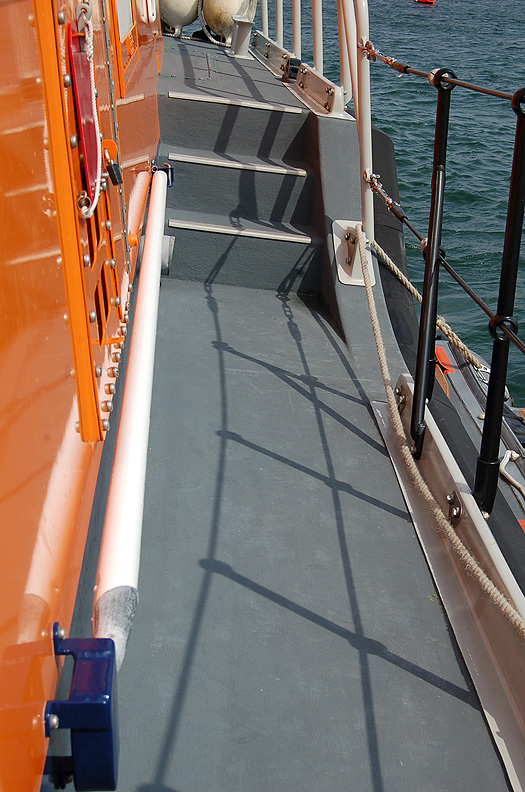
The boat hook on Achill lifeboat
FISHERMEN TELL OFF THE RNLI
Dick Robinson, former lifeboat crewman from Valentia Island and author of several books about the lifeboat service, has written to me about my visit to the Achill Island lifeboat when I said I had learned that the two boat hooks on modern lifeboats are the only items remains as a tradition from the past."
Dick confirms that this is a reminder of the rowing lifeboat days:
"The RNLI at that time issued a rather condescending circular that white oars were to be used to starboard and blue to port, as 'the orthodox terms, starboard and port are rarely used in lifeboat work since many lifeboatmen are unaccustomed to nautical phraseology.' The Penlee crew reversed the placings as a protest against the tone of that circular.
"The orders from the Coxswain would be 'Forward the white, Back the blue' or reverse as appropriate. The boats would have no steerage way working in close, so the rudder would not be effective and so oars had to be worked all the time. The oars were the subject of considerable research as oars breaking during beaching or launching operations could be fatal. In 1866 trials were carried out involving 38 different types of wood. The best oars were found to be made from young trees in Norwegian and Baltic Wood, followed by oars made from planks of the same woods. Oregon Pine was also good. A balance had to be struck between oars which would break under ordinary conditions and ones which would not break if the lifeboat struck bottom in shallow waters and thereby might capsize her. Later oars were balanced with lead inside."
Thanks Dick for this information on a fascinating topic.
PIRATES IN BALTIMORE
The sacking of Baltimore village, a very popular sailing destination in West Cork, is the topic of a 'PIRATE SEMINAR' – an unusual addition to the list of maritime events this summer. It will be held next weekend, starting on Friday night, June 29 and running until Sunday, July 1, including events for all the family.
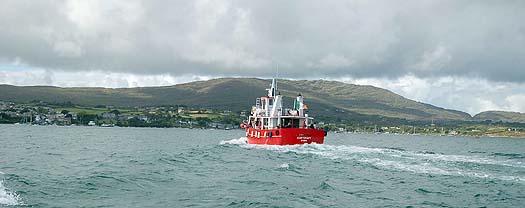
The Schull – Baltimore – Cape Clear ferry departs Baltimore
Des Ekin, Assistant Editor with the Sunday World and author of the book – 'The Stolen Village' will discuss the 'Sack of Baltimore' in 1631 when inhabitants were taken off to slavery in Algiers. Connie Kelleher, Underwater Archaeologist with the Dept. of the Arts, Heritage and the Gaeltacht's Underwater Unit will discuss piracy in southwest Ireland in the seventeenth century.
New to Baltimore is a permanent 'piratical exhibition' at Dún na Séad castle, with details of the raid on the village and copies of rare graphics from the seventeenth century depicting the story of the Baltimore captives who were taken into a life of slavery. Details are also shown of the activities of the O'Driscoll clan and their notorious involvement with the men of Waterford during the middle ages. A depiction of Thomas Crooke, the English 'pirate/planter' is also featured. An accompanying feature of the exhibition is a new book by Bernie McCarthy called 'Pirates of Baltimore,' containing images of lifestyles and events associated with the piratical history of the village. Did you ever imagine the respectable Baltimore of today to have such a history!
The exhibition is open daily 11am – 6 pm.
THE BEAUTY OF TRADITION
There is a great beauty in traditional boats and the one pictured here, the Peel Castle, was for me the star of this year's Crosshaven Traditional Boats Gathering. She is owned by Graham Bailey and deservedly won the top prize at the event. A fishing lugger she was built back in 1929 at Porthleven in Cornwall, carvel, pitch pine planking on oak frames and her original engine power was 2 x 25 hp Alphas - currently 120hp Ford D series.
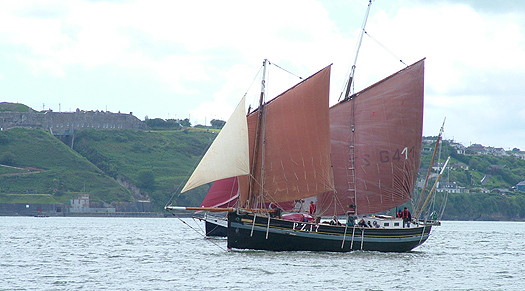
The Peel Caslte racing off Crosshaven
She was registered PZ17 at Penzance, later BM17 Brixham, Devon. She also fished out of Fleetwood from1968 and finished fishing in 1977 when she was de-registered. Re-registered in Skibbereen in 2008, she has sailed extensively in European waters. Restoration work was done at Hegarty's Old Court Boatyard and is impressive. Graham, a shipwright, also restored her internally. Visitors aboard were very impressed.
GASSY HUMANS!
Human-produced gas emissions are a significant cause of ocean warming!
Average ocean temperatures have been rising by 0.045 degrees per decade for the past half-century and natural fluctuations alone "do not explain warming in the upper layers of the planet's oceans," according to the Lawrence Livermore National USA National Laboratory. "Human greenhouse gas emissions are an added ingredient and strengthen the conclusion that most of the global ocean warming over the past 50 years is attributable to human activities," according to Livermore climate scientist Peter Gleckler.
The Californian Laboratory which made these findings in a desktop computer modelling study of the Atlantic and Pacific Oceans also researches protection against weapons of mass destruction!
To Email your comments to THIS ISLAND NATION: [email protected]
Follow Tom MacSweeney on Twitter @TomMacSweeney and on Facebook
Irish Olympic Sailor Turned Race Officer Set for Galway's Photo Finish in the Volvo Ocean Race
#vor – By the time the fleet of six boats reaches Galway at the start of July, they will have travelled 39,000 nautical miles, the equivalent of travelling from Ireland to Australia four times, yet it looks like the race could be decided on a 60 minute inshore race just metres from the shore. And the man responsible for making sure the race runs smoothly is former Northern Ireland Olympian Bill O'Hara from Ballyholme in County Down.
The Volvo Ocean Race is a round-the-world yacht race that started in Alicante last October and has called in ports such as Abu Dhabi, Cape Town, Itajai in Brazil, Sanya in China, Auckland, Miami and a nail biting finish is set for Galway in a matter of weeks. Eleven crew on board each boat battle the elements in state-of-the art 70ft racing yachts capable of remarkable speeds.
Bill O'Hara is a two-time Irish sailing Olympian who learnt to sail in Ballyholme. In total Bill has been involved in six Olympics in various capacities including coach and judge. Bill was also the Principle Race Officer (PRO) for the last Volvo Ocean Race, the role he currently holds. Considering the race is the largest, most high profile offshore yacht race in the world, Bill described it as an honour to even be considered for such a role.
When asked what the role entailed, Bill said: "At first glance it may seem simple, organising a few inshore races and a few offshore races for six boats, all with fully professional crews. When you then start to consider each race has in the region of 2,000 spectator boats on the water, numerous helicopters, multi million pound boats that will be racing mere meters from the shores of some of the most impressive cities of the world to some of the most remote places on earth, all at speeds of over 40mph it starts to get a bit more difficult."
Bill himself admits his early years in sailing were more for fun and they weren't taken too seriously until the Laser European Championships came to his home club in 1979. It was at this point that Bill started to take sailing seriously and has had a remarkable sailing record and career ever since.
Bill added: "I am very fortunate to have been involved with such prestigious events around the world but this edition of the Volvo Ocean Race is shaping up to be the most exciting. For what started off to be an event dominated by Team Telefonica there are now four teams in the running for the top spot. The way it's looking I think the race could be decided during the inshore race in Galway which will be one of the most exciting sailing races ever seen, all within meters of the Galway shoreline.
"The Volvo Ocean Race has changed how the world views sailing. Spectators and fans are being brought closer and closer to the action all the time. Media crew members capture the action on board, helicopters capture the inshore action and live tracking allows for 24-hour monitoring meaning fans can feel part of the action 24/7, no matter where they or the boats are. Another incredibly popular innovation is the 'Virtual Race', which gives fans the chance to take part in all the legs via an impressive online game with over 160,000 people taking part."
The action doesn't just take place on the water - each stopover is a festival in itself and the Galway finish is set to be spectacular. During the nine day period from 30th June – 8th July there will be over 260 events including concerts from international bands, gigs from comedians such as Dara O'Briain, fashion shows, business expo's on innovation, sustainability, marine, and numerous on-the-water activities such as try sailing and kite surfing demonstrations.
Speaking about what Galway has to offer visitors, Bill said: "I can assure any visitors they will not be disappointed, almost all events are free of charge, the entire city is getting involved and for those who want to watch the action there will be giant screens and ample space along the scenic Galway coastline. The competitors and teams who took part in the last race agreed that the hospitality and reception in Galway was the most memorable. In 2009 well over 600,000 people visited the city and as this year is the final stop, and also as the race is so closely matched the atmosphere is going to be electric over the nine days."
The Galway stopover runs from the 30th June – 8th July. The boats will be racing on Thursday, Friday and Saturday all within close range of the shore. Almost all of the 260 events are free of charge.
#VOR – Thousands will be given an opportunity to learn to sail during the spectacular finale of the Volvo Ocean Race on Galway Bay next month say Galway organisers who have lined up 42 separate on-water events which will take place on Galway Bay during the course of the Volvo festival.
Details were announced at a briefing by Galway Bay Sailing Club and The Irish Sailing Association in the House Hotel last Friday night.
As part of a nine day seafaring festival built around the race finale sailing clubs want to get a record breaking number of people onto the water between June 30th and July 8th.
The arrival of the Volvo fleet will put the city at the centre of a global media spotlight, the briefing was told, but for many local sailors the highlight of the festival will be an opportunity to take part in one or other of the highly competitive sailing regattas on the Bay or to have a go on one of the high speed Volvo tri sailboats.
The events being organised by Galway Bay Sailing Club include the Irish Multihull National Championships which has attracted an entry of over 40 boats. These high speed craft will be seen off Salthill on Sat 30th June & Sun 1st July.
The club is also hosting GB12 cruiser racing series and 50 yachts are lining up for this three-day event, attracting boats from Westport, Limerick, Clifden, Sligo, Galway and the UK.
Galway is also taking a leading role in the dramatic round Rockall Race, which starts from the city on Sunday 24th, the same day as the Round Ireland race from Wicklow.
One of the biggest gathering of boats ever to happen will take place on Sunday 1st July at Galway docks and will be organised by GBSC member Pierce Purcell, who is expecting up to 200 boats to take part in the colourful parade of sail. Weather permitting, the fleet will meet at Salthill and join a junior parade of sail off Mutton Island.
Pierce wants all water users to join this parade of sail including yachts, sailing dinghies, traditional boats, power boats, ribs, fishing boats, scout groups windsurfers and canoes. A reviewing vessel will anchor off the channel to the docks and a band will welcome the armada into the marina to add to the shore festival just a day before the Volvo 70s arrive.
One of the highlights will be the Irish Disabled Sailing Association regatta. Over 100 sailors who have physical disabilities have already applied for the accessible sailing series.
This joint event is designed to encourage people with disablities to take to the water.
GBSC are also running a schools team-racing event. John Killeen, President of Let's Do it Global said he was delighted with the enthusiasm of the sailing clubs and of the 2,000 volunteers from all over Ireland who will assist in running the biggest sailing event of the year.
The Mayor of Galway Hildegarde Naughton said this 'event was huge for not only Galway, but all of Ireland' and would attract massive media coverage as well as visitors to Galway city.
Over twenty sailing clubs and training centres including power boating, windsurfing, scouting, the RNLI, the Harbour Company and Irish Water Safety were represented at the House Hotel in Galway at the weekend.
Galway Volvo Ocean Race Centrepiece is Free Open Air Concert
#vOR – The biggest free open air music festival of the year is expected to attract over 150,000 visitors to Galway and make the city rock like never before during the dramatic final week of the Volvo Ocean Race.
The nightly concerts on the huge waterfront stage will feature some of the country's best known and most exciting new bands and entertainers. They will also be one of the centerpieces of the global TV coverage of the event.
During the 2009 Volvo Stopover in Galway, tens of thousands of music fans thronged the dramatic waterfront setting each night for similar free concerts and described the atmosphere and the performances as "electrifying and incomparable".
The organizers of this year's festival say they believe it will be even more memorable with performances by incredibly talented bands, more elaborate staging and larger audience capacity.
Head of Entertainment for the 2012 Galway Volvo Festival Lisa Hallinan said "This is going to be a spectacular opportunity for music fans to come to Galway and enjoy nine nights of non stop free entertainment in a truly wonderful location – between the sea and the city".
"Anybody who was in Galway in 2009 will understand the sheer scale and the energy of the event. Now the city is once again preparing to throw the party of the year and live up to its reputation for delivering world class festivals."
The Volvo Ocean Race Finale in Galway will be at the centre of a global TV audience of millions with crews from 47 TV stations arriving in the city. The concerts will be part of the backdrop to many of the stories on the race finale and festival in Galway.
Maverick Sabre, one of Ireland's hottest tickets and described by BBC1 as the "the male Amy Winehouse" will headline the festival, opening on the Main Stage on Saturday June 30th. He will be supported by rising stars and local band 'The Kanyu Tree'.
On Sunday July 1st and Monday July 2nd the fantastic line up of Thin Lizzy, The Family Stone, Ryan Sheridan, Niwel Tsumbu and The Deans will have the city and the docks area pulsating with a vibrant music festival beat.
The week's line up also includes Galway's legendary Saw Doctors, who will be leading the city in celebration as the Volvo Fleet arrives form Lorient in France at the end of the 39,000 nautical miles round the world race. Few will ever forget the performance of the Saw Doctors during the arrival of the Volvo fleet at the 2009 stopover in Galway.
One of the most spectacular days of the week-long festival will be July 4th US Independence Day which will see a gigantic fireworks display on the night skyline and the Hypnotic Brass Ensemble performing on the Main Stage.
Trad claims centre stage on Thursday night with Altan's Mairead Ni Mhaonaigh and Galway's own trad supergroup De Danann, who are expected to be one of the biggest crowd pullers of the week.
Celebrating their 25th anniversary, Galway's storming rock band The Stunning will play their only Galway gig of 2012 on Friday July 6th reliving their unforgettable performance at the 2009 festival when they appeared on stage in full seafaring costume.
Sharon Shannon and her 42 piece orchestra, who wowed audiences at the Auckland Stopover in New Zealand earlier this year, will be the star attraction at the Grand Finale Concert following the official prize giving ceremony.
The week of non-stop entertainment will also feature Hot 8 Brass Band, Túcan, The Rip Tide Movement, Bipolar Empire, O Emperor and Stephen James & Band. A programme of family friendly street theatre and roving performances will run throughout the Race Village and the city. The acts will include LUXe, Extreme Rhythm, Cillian Rodgers, Bui Bolg, Marcel So, Youth Ballet West and Groupo Candeas.
John Killeen, President Volvo Ocean Race Galway, says that the open air concerts are expected to attract record breaking audiences and will be at the centre of an international media showcase for the city.
"A music festival of this scale could not take place without the financial backing and generous support of Galway City Council which is funding the entire entertainment line up," he said.
Speaking on a visit to the site of Race Village, Joe O'Neill City Manager said "We believe that the Finalé of the Volvo Ocean Race will be a hugely successful event for the city. We are glad to be working with the Galway Volvo Ocean Race team to ensure that the biggest event in Ireland this year will have a lasting and worthwhile legacy for GalwayCity."
New Twitter Buoy Starts Tweeting
#twitterbuoy – Up to the minute information on the progress of the 39,000 mile Volvo Ocean Race – headed for Galway in three weeks time – will be "tweeted" to millions around the world from a high tech "Twitter Buoy" which will "go live" in Galway Bay.
The Galway 'Twitter' Buoy was launched by the Irish Lights Vessel "Granuaile" as previously reported by Afloat.ie at a location close to Mutton Island and will transmit a constant flow of data on the race, the weather conditions being experienced by the sailors and other ocean and meteorological data.
The Galway 'Twitter' Buoy will be accessible on Twitter @Galwaybuoy. Its information stream will also be passed onwards through Facebook and the Internet. It will transmit from today until mid July.
The launch of the service – a Volvo Ocean Race first - has come about through a collaboration between the Commissioners of Irish Lights, the Marine Institute, Techworks Marine, Smartbay Ireland and IMERC partners, (Irish Maritime and Energy Resource Cluster).
The eight metres high navigational buoy is fitted with multiple environmental sensors and electronic transceivers including AIS (Automatic Identification system) and RACON (Radar beacon) and will 'tweet' the whereabouts of the Volvo boats as they head for the nail biting Race Finale in Galway. Photo:Andrew Downes
Twitter Buoy off Galway is a Volvo Ocean Race First
#VOR – Up to the minute information on the progress of the 39,000 mileVolvo Ocean Race – headed for Galway in three weeks time – will be "tweeted" from a high tech "Twitter Buoy" which will "go live" in Galway Bay today (Thursday).
The Galway'Twitter' Buoy will be launched by the Irish Lights Vessel "Granuaile" at alocation close to Mutton Island and will transmit a constant flow of data on the race, the weather conditions being experienced by the sailors and other ocean and meteorological data.
The 'round the world / 'round the clock' transmissions from the buoy will link the race to the140 million active users of the "Twitter" social media network across the globe.
The Galway 'Twitter' Buoy will be accessible on Twitter@Galwaybuoy. Its information stream will also be passed onwards through Facebook and the Internet. It will transmit from today until mid July.
The launch of the service – a Volvo Ocean Race first - has come about through a collaboration between the Commissioners of Irish Lights, the Marine Institute, TechworksMarine, Smartbay Ireland andIMERC partners, (Irish Maritime and Energy Resource Cluster).
The eight metres high navigational buoy is fitted with multiple environmental sensors andelectronic transceivers including AIS (Automatic Identification system) andRACON (Radar beacon) and will 'tweet' the whereabouts of the Volvo boats as they head for the nail biting RaceFinale in Galway.
Speaking in Galway at the official announcement of the Ocean Wealth Showcase taking place duringthe Volvo Ocean Race Finale, Yvonne Shields, Chief Executive of the Commissioners of Irish Lights said that the Galway 'twitter' buoy will communicate actively on marine safety information, race updates and eventsassociated with this great occasion.
"While fog signals and whistles may be a thing of the past, the Commissioners of Irish Lights are working on new Aids to Navigation using next generation technologies to communicate with sea goers and navigators around our coasts" said Shields.
Taking place at theVolvo Global Village from 30th June to 8th July, theOcean Wealth Showcase will highlight Ireland's marine resources andsectors to the business community and members of the public attending the Volvo Ocean Race Finale. A number of different events are planned including an Ocean Wealth Exhibition (30th June- 8th July), Family Fun Days(30th June & 1st July), and a Marine Career and Recruitment Event (5th & 6th July).
"Getting more fromour Marine Resources through Technology"- The 3rd Annual Smart OceanConference at the Marine Institute on Monday 2nd July is expected to attract over 120 national andinternational delegates who will hear discussions from the Marine and ICTsectors, State agencies and Research Institutes.
A Symposium on the Marine Environment on 6th July features a number of expert speakersincluding Koen Verbruggen, Geological Survey of Ireland, Dr. Ken Whelan authorand international researcher UCD, Dr. Anthony Grehan, NUIG and Michael O'Cinneide, Director of Environmental Monitoring, Environmental Protection Agency.
The inaugural SmartOcean Innovation Exchange on 3rd July, aims to support companies toinnovate in the Marine Sector and to encourage investment opportunities.
Concluding theweeklong showcase on Saturday 7th and Sunday 8th July isa 'Stay Safe at Sea' event which will provide safety talks and advice to visitors including life jacket health checks and stay safe at sea practicalworkshops.
Updates fromGalwayBuoy can be followed on twitter.com/Galwaybuoy
Big Changes In Store For Future Volvo Ocean Races
#VOLVO OCEAN RACE - A shorter route with smaller boats and streamlined teams are among the big changes to the Volvo Ocean Race expected to be announced in the next few weeks, as the Daily Telegraph reports.
The changes come amid concerns over the high cost of competing in the round-the-world yacht race, which fielded a fleet of just six boats for the current campaign.
“The world is changing and we need to adapt to that so we have had a lot of discussions about the boat size, the route and logistics,” said race CEO Knut Frostad.
The race boats will see "significant changes", he added, with many expecting the current VOR 70 yacht to be replaced with a 62-foot boat that gives designers greater leeway.
Smaller boats will also mean smaller teams, while the number and duration of the race's stopovers is set to be reduced, making big savings in terms of accommodation and logistics.
Race organisers are expected to announce the new plans before the fleet departs Lorient for Galway on the final leg of the current race.
The Daily Telegraph has more on the story HERE.




























